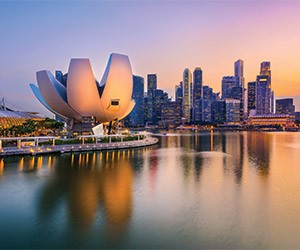Billed as the food capital of Asia, Singapore’s unique ethnic tapestry, intertwining Chinese, Malay, Indian and English influences, is reflected through its wide variety of cuisines.
“In a country where eating ranks as one of the nation’s top pastimes, it is no surprise that food is an integral part of Singapore’s national identity,” says Kershing Goh, regional director for the Americas at the Singapore Tourism Board. “Blessed with a multicultural heritage that is reflected in our food, visitors are spoiled for choice by a multitude of options. These range from our world-renowned street food that is available at over 100 hawker centers around the island to our dynamic and world-class fine dining scene.”
According to Goh, in recent years, Singapore’s innovative culinary space has become home to celebrity chefs like Mario Batali, Wolfgang Puck and Daniel Boulud.
“Singapore is also witnessing the emergence of an increasing lot of promising young local chefs who break new ground by concocting dishes that present traditional flavors with modern flair,” Goh explains.
One example is Singaporean-born chef Justin Quek at Sky on 57, which is located on Sands SkyPark on the 57th floor of Marina Bay Sands. Quek has developed a modern, “Franco Asia” cuisine, blending French techniques and Singaporean flavors. Private dining for up to 20 is available, or groups can use the Terrace Bar for up to 150.
Other foodie spots with private dining include Todai, which offers four private dining rooms, and Fleur de Sel Le Restaurant, with private dining for up to 12.
Groups can also visit the Tiong Bahru neighborhood, which is packed with restaurants, cafes and bakeries. Award-winning chefs are streaming in, such as Janice Wong of 2amDesertbar fame.
For a taste of Singapore’s past, groups can visit chef Malcolm Lee’s authentic Peranakan diner, Candlenut Kitchen. A name given to the descendants of 15th and 16th century Chinese who migrated to Java and Malaya and integrated into the local cultures, Peranakan, or Nyonya, food blends southern Chinese cooking styles with spicy Malay and Indonesian ingredients.
“Most young chefs want to cook in Western restaurants,” says 26-year-old Lee. “They think Peranakan food is too old-fashioned. My aim is to refine Peranakan food, to make it into a fine-dining experience. I’d like to see it become glamorous, maybe even cool.”
For another authentic experience, many hawker centers have large seating areas, which companies can reserve for group dining with local DMCs. Maxwell Road Hawker Centre in Chinatown, for example, sprawls with over 100 stalls, providing one of the biggest varieties of local food in Singapore.
Groups can also head to Chinatown Food Street for a taste of old Chinatown, replete with street hawker stalls, shophouse restaurants as well as alfresco dining.
To experience the charm of Singapore in the 1960s, including themed decor from the past, groups can organize events for up to 450 at the Singapore Food Trail.
“The Singapore Food Trail is unique as it transports diners back to a bygone era, to a time when people savored popular local delights along the roadside,” says Wallace Ang, special projects, business development. “The dining experience will especially delight foreign delegates with its selection of some of Singapore’s best hawker fare.”
Food Tour Singapore offers walking tours including the Chinatown Food Tasting tour, which also visits historical and cultural landmarks, hawker centers and a local wet market.
Wok ’n’ Stroll also offers private culinary tours for corporate groups, including behind-the-scenes visits to top restaurants, tours focusing on Nyonya cuisine, food photography tours and night food tours.
Groups can get hands on with one of Singapore’s many cooking-class options, such as Food Playground.
“We offer two kinds of programs: cultural cooking classes and team-building workshops for corporate groups,” says Daniel Tan, managing director. “Unlike other schools that focus on teaching participants to cook local dishes, we go one step further to introduce Singapore's food heritage and culture. Participants get to understand interesting snippets of local dishes, their origins, how to enjoy local food like a local.”
For its teambuilding events, Food Playground incorporates different types of icebreaker games revolving around food. In one example, Design, Build & Sell Challenge, participants have 15 minutes to work with food items and craft materials to build a 3-D structure and present their concept to the opponent teams, according to Tan.
At Open Kitchen, groups can choose from a variety of culinary classes and challenges, such as the Mystery Box Challenge, where participants, with the help of professional chefs, have to conceptualize their own menu based on the secret ingredients found inside the mystery box.
Groups can also participate in a Singapore Amazing Chef Race, as well as the Dim Sum Assassin challenge, which requires teams to transform dim sum into fine art.
Food sorceress Ruqxana Vasanwala of Cookery Magic hosts cooking classes in her own home, followed by a sit-down meal. Her Corporate Home Cooking Workshop can host up to 20, with the group divided into teams.
Vasanwala also organizes a Luxury Yacht Corporate Cooking Class for up to 16, held on a 90-foot luxury yacht.
Most popular for groups is Cookery Magic’s Pulau Ubin Corporate Cooking Escapade for up to 80, which takes place on an island off Singapore. The class is conducted in a 100-year old kampong (village) house and the cooking is normally conducted in the garden.







